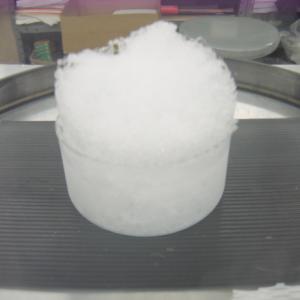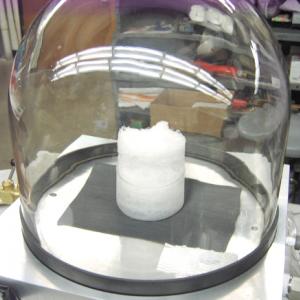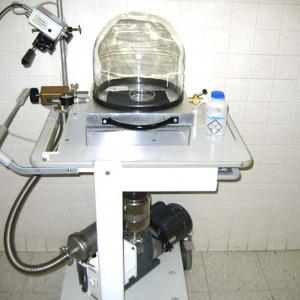College of Liberal Arts & Sciences
4C20.40 - Freezing Liquid Nitrogen or Liquid Argon - Reduced Pressure
Video Credit: Jonathan M. Sullivan-Wood.
Place 100 to 150 ml of liquid nitrogen into the evaporating dish and wait for the dish to cool down so that the liquid nitrogen quits boiling violently. Put the gloves on and then place the dish in the center of the bell jar. Reduce the pressure and observe that the liquid nitrogen will appear to turn to a solid snow after about 10 seconds. Also note that the snow will turn back to a liquid if it is returned to atmospheric pressure.
SAFETY NOTE: Make sure you place the protective cover over the bell jar before you start reducing the pressure in the bell jar.
The same procedure for freezing liquid nitrogen will also work to freeze liquid argon. The hard part is making the liquid argon as you will have to do this by gently blowing a stream of argon gas into a test tube that is immersed in liquid nitrogen. A balloon on the test tube will help save gas, as you can fill the balloon and as the gas condensed the balloon will collapse. Keep repeating this process until you have as much liquid argon as you need.
- Paul Hewitt, "Answer to January 2018 Figuring Physics", TPT, Vol. 56, #2, Feb. 2018, p. 117.
- Thomas C. Lamborn, Robert Mentzer, "Liquid Carbon Dioxide and Solid Nitrogen", TPT, Vol. 32, #8, Nov. 1994, p. 508.
- Harald Jensen, "Freezing Nitrogen: A Modification", AJP, Vol. 36, #10, Oct. 1968, p. 919.
- R.L. Wild, D.C. McCollum, "Dramatic Demonstration of Change of Phase", AJP, Vol. 35, # 6, June 1967, p. 540.
- "This Month in Physics History: January 19, 1894: James Dewar Produces Solid Air", APS News, Series II, Vol. 21, #1, Jan. 2012, p. 2.
- "Freezing Nitrogen: A Modification", Apparatus Notes, July 1965-December 1972, p. 76.
Disclaimer: These demonstrations are provided only for illustrative use by persons affiliated with The University of Iowa and only under the direction of a trained instructor or physicist. The University of Iowa is not responsible for demonstrations performed by those using their own equipment or who choose to use this reference material for their own purpose. The demonstrations included here are within the public domain and can be found in materials contained in libraries, bookstores, and through electronic sources. Performing all or any portion of any of these demonstrations, with or without revisions not depicted here entails inherent risks. These risks include, without limitation, bodily injury (and possibly death), including risks to health that may be temporary or permanent and that may exacerbate a pre-existing medical condition; and property loss or damage. Anyone performing any part of these demonstrations, even with revisions, knowingly and voluntarily assumes all risks associated with them.


